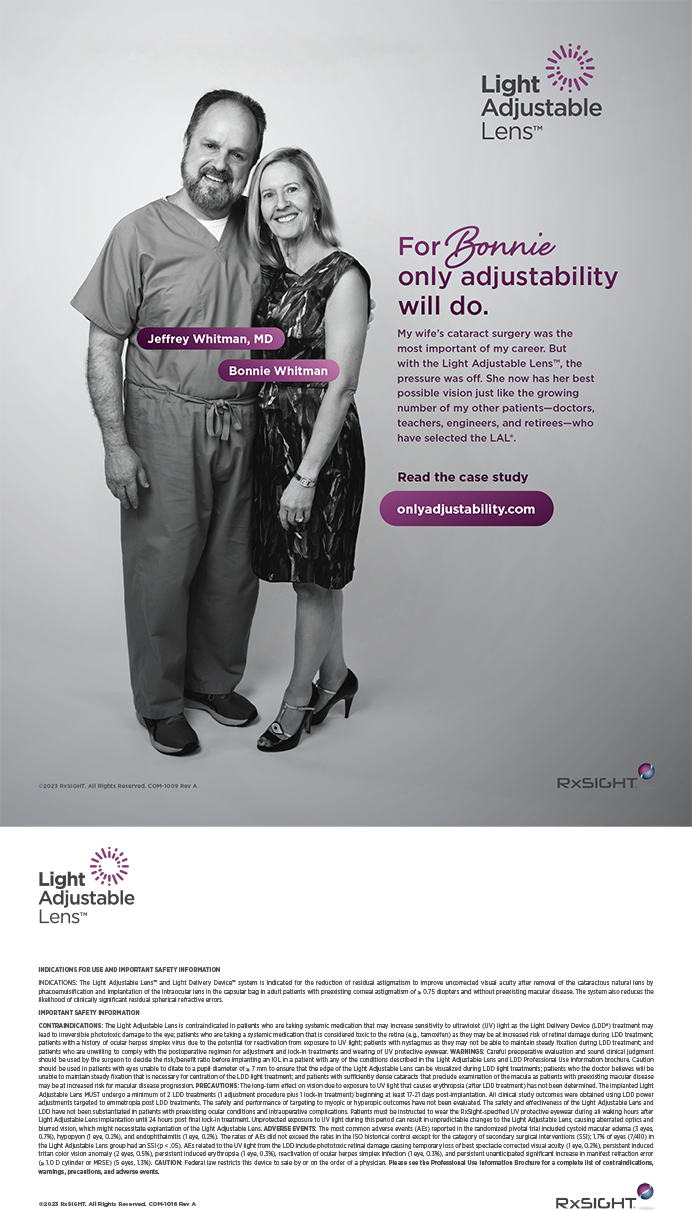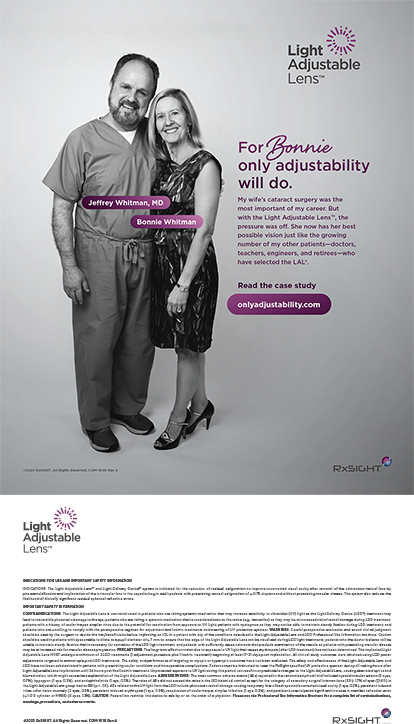The FDA clinical study of gatifloxacin (ZYMAR 0.3%; Allergan, Inc., Irvine, CA) was essentially an efficacy study that focused on the drug's overall level of coverage against gram-positive and gram-negative organisms. Based on this study experience, I feel that gatifloxacin offers all the advantages that surgeons have come to depend on with fluoroquinolones. In addition, gatifloxacin offers some distinct additional benefits, such as more powerful coverage and greater protection against resistance, compared with previous-generation agents.
WEIGHING IN ON THE DEBATE
As far as the debate over third- and fourth-generation fluoroquinolones, I think most physicians agree that an agent with an 8-methoxy group is a fourth-generation fluoroquinolone. Core principles behind efficacy show first-, second-, and third-generation organization, and an 8-methoxy group is clearly the next step. I consider an 8-methoxy group to be a fourth-generation agent, and I think that those involved in fluoroquinolone pharmacology agree.
THE NEED FOR INCREASED RESISTANCE PROTECTION
Although the third-generation fluoroquinolones have served ophthalmologists very well, as is the case with all antibiotics, microbial resistance to those agents is beginning to increase (quite dramatically in many parts of the country). Many of the gram-positive organisms, particularly some of the Streptococcus species, are reportedly showing a resistance of 50% and higher in the US. Even some gram-negative organisms, including the feared Pseudomonas species, are showing some resistance to third-generation agents, despite the historically effective coverage that these agents have provided.
When an antibiotic begins to enter a resistance curve, the effect is slight at first and then becomes quite steep. We are starting to move into that steeper resistance side with previous-generation fluoroquinolones, at which point the antibiotics can lose much of their efficacy. Even the third-generation fluoroquinolones have shown this specific resistance problem. Gatifloxacin's 8-methoxy group gives the agent two different mechanisms of action (topoisomerase IV and DNA gyrase) against gram-positive organisms (Figure 1). This “double shot” for killing bacteria significantly improves gatifloxacin's efficacy compared with third-generation fluoroquinolones. Additionally, the dual mechanism of action provides an uncommonly strong level of action against microbial resistance over time. In order to resist this dual mechanism, microbes must develop a double mutation spontaneously, which will be much more difficult to achieve. Therefore, this specific antibiotic may be useful for a much longer period of time than previous-generation fluoroquinolones.
FOURTH-GENERATION BENEFITS
Gatifloxacin is designed to be particularly effective against gram-negative organisms. It features unusual properties to combat the highly feared atypical mycobacteria that has become so problematic for refractive surgeons. In addition to this broader spectrum of coverage, all of the minimal inhibitory concentrations are stronger in gatifloxacin than in previous-generation fluoroquinolones. Finally, gatifloxacin has the same penetration rate as ofloxacin, a characteristic that we have shown will be extremely important.
CHANGING SCHOOLS OF THOUGHT
Although the old school of thought says to reserve your big guns for later use, this mindset may be harmful when applied to fluoroquinolones. If bacterial resistance is beginning to build against third-generation fluoroquinolones such as ciprofloxacin that have only one mechanism of action, then it is wrong to continue using these agents and allow resistance to continue to build. Permitting organisms to develop stronger resistance against one mechanism of action will render third-generation fluoroquinolones ineffective and reduce the effectiveness of fourth-generation agents such as gatifloxacin to one mechanism of action. Using fourth-generation agents now will actually prolong the overall efficacy of the fluoroquinolones. I feel strongly that physicians should begin using fourth-generation fluoroquinolone agents in order to prevent microbial resistance to one site of action.
STUDY EXPERIENCE
The number of bacteria that showed resistance to gatifloxacin in the FDA clinical study was at or close to 0% across a very broad spectrum. The agent's time to clearing any bacterial load was also very good, and its coverage in regard to all of the gram-positive and gram-negative organisms is expanded and enlarged over that of third-generation agents.
FAMILIAR PROPERTIES
Because ofloxacin is the most popular antibacterial product among ophthalmologists, I feel it is important to point out that gatifloxacin shares a similar pH, penetration, and dosage in the anterior chamber—all of the advantages physicians feel are important in a fluoroquinolone. However, gatifloxacin's protection against resistance is much higher, and it has a much broader spectrum of coverage. It is rare to encounter a new product that does not compromise a single standard while offering several distinct advantages. The primary benefit of this agent is its improved gram-positive and gram-negative coverage in much lower concentrations than previous-generation agents—in other words, a distinctly improved kill rate. Additionally, gatifloxacin's dual mechanism of action will significantly prolong the agent's ability to deliver that kill rate. We only gain by using gatifloxacin.


